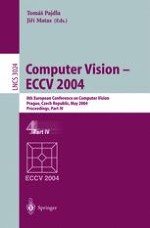2004 | OriginalPaper | Buchkapitel
Coaxial Omnidirectional Stereopsis
verfasst von : Libor Spacek
Erschienen in: Computer Vision - ECCV 2004
Verlag: Springer Berlin Heidelberg
Enthalten in: Professional Book Archive
Aktivieren Sie unsere intelligente Suche, um passende Fachinhalte oder Patente zu finden.
Wählen Sie Textabschnitte aus um mit Künstlicher Intelligenz passenden Patente zu finden. powered by
Markieren Sie Textabschnitte, um KI-gestützt weitere passende Inhalte zu finden. powered by
Catadioptric omnidirectional sensors, consisting of a camera and a mirror, can track objects even when their bearings change suddenly, usually due to the observer making a significant turn. There has been much debate concerning the relative merits of several possible shapes of mirrors to be used by such sensors.This paper suggests that the conical mirror has some advantages over other shapes of mirrors. In particular, the projection beam from the central region of the image is reflected and distributed towards the horizon rather than back at the camera. Therefore a significant portion of the image resolution is not wasted.A perspective projection unwarping of the conical mirror images is developed and demonstrated. This has hitherto been considered possible only with mirrors that possess single viewpoint geometry. The cone is viewed by a camera placed some distance away from the tip. Such arrangement does not have single viewpoint geometry. However, its multiple viewpoints are shown to be dimensionally separable.Once stereopsis has been solved, it is possible to project the points of interest to a new image through a (virtual) single viewpoint. Successful reconstruction of a single viewpoint image from a pair of images obtained via multiple viewpoints appears to validate the use of multiple viewpoint projections.The omnidirectional stereo uses two catadioptric sensors. Each sensor consists of one conical mirror and one perspective camera. The sensors are in a coaxial arrangement along the vertical axis, facing up or down. This stereoscopic arrangement leads to very simple matching since the epipolar lines are the radial lines of identical orientations in both omnidirectional images.The stereopsis results on artificially generated scenes with known ground truth show that the error in computed distance is proportional to the distance of the object (as usual), plus the distance of the camera from the mirror. The error is also inversely proportional to the image radius coordinate, ie. the results are more accurate for points imaged nearer the rim of the circular mirror.
